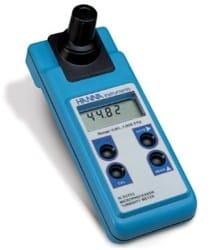
Hanna Instruments-93703-11 Portable ISO Compliant Turbidity Meter with Data Logging and PC Connectivity
The Hanna Instruments-93703-11 is a high accuracy benchtop turbidity meter used to determine the turbidity of water and wastewater with high precision in the field as well as in the laboratory. The meter is supplied complete with AMCO-AEPA-1 primary turbidity standards used for calibration and performance verification. The Hanna Instruments-93703-11 meets and exceeds the requirements of the ISO 7027 Method for turbidimetric measurements. Additionally, this meter contains a real-time clock and the capabilities to log measurements and transfer them to a PC using the Hanna Instruments-92000 software.
- Auto shut-off
- Positive-locking cuvette system ensures cuvette is firmly placed in the cell
- Logging and real time clock
The Hanna Instruments-93703-11 Portable ISO Compliant Turbidity Meter with Data Logging and PC Connectivity is specially designed for water quality measurements, providing reliable and accurate readings, even within low turbidity ranges. The instrument is based on a state-of-the-art optical system which guarantees accurate results, assures long term stability, and minimizes stray light and colour interferences. Periodic calibration with the Hanna Instruments-93703-0, -05, and -10 standards compensates for any variations in intensity of the LED light source. The 25 mm round cuvettes composed of special optical glass guarantee the repeatability of turbidity measurements. Hanna Instruments-93703-11 also includes a real-time clock and log-on-demand capability.
Key Features
- Single Beam Design - The Hanna Instruments-93703-11 measures turbidity using a light detector at 90° for detection of scattered light. Turbidity measurements can be made in the 0.00 to 1000 FTU range.
- ISO Compliant - The Hanna Instruments-93703-11 meets and exceeds the requirements of ISO 7027 method for turbidity measurements by use of an infrared LED light source. As this meter has been designed to follow this ISO method, the units are displayed in FTU (Formazine Turbidity Unit); FTU is equivalent to the other internationally recognized unit of NTU (Nephelometric Turbidity Unit).
- Calibration - The Hanna Instruments-93703-11 has a powerful calibration function that compensates for variation in light intensity. The calibration can be done using the supplied calibration solutions or user-prepared standards. A two or three-point turbidity calibration can be performed by using the supplied (0, 10, and 500 FTU) standards.
- Data Logging and Real Time Clock - This meter has the capabilities to log up to 199 measurements that can then be transferred to a PC using the Hanna Instruments-92000 software. Additionally the feature of a real time clock allows time to be stored with GLP data.
- AMCO AEPA-1 Primary Turbidity Standard - The AMCO AEPA-1 supplied standards are recognised as a primary standard by the USEPA. These non-toxic standards are made of styrene divinylbenzene polymer spheres that are uniform in size and density. The standards are reusable and stable with a long shelf life.
- Last Calibration Date - The Hanna Instruments-93703-11 allows the user to store the last calibration date. Recall of the last calibration date is simple with a press of the “DATE” button on the face of the meter.
- Low Battery Indicator - A "LO BAT" indication will appear on the lower right corner of the display when the batteries are low and need to be replaced. At this point, the instrument can still perform approximately 50 measurements. When the battery is too low to perform reliable measurements, a message appears and the meter will automatically switch off.
Significance of Use
Turbidity is one of the most important parameters used to determine the quality of drinking water. Once considered as a mostly aesthetic characteristic of drinking water, significant evidence exists that controlling turbidity is a competent safeguard against pathogens. In natural water, turbidity measurements are taken to gauge general water quality and its compatibility in applications involving aquatic organisms. The monitoring and treatment or wastewater was once solely based on the control of turbidity. Currently, the measurement of turbidity at the end of the wastewater treatment process is necessary to verify that the values are within regulatory standards.
Turbidity of water is an optical property that causes light to be scattered and absorbed, rather than transmitted. The scattering of light that passes through a liquid is primarily caused by the suspended solids present. The higher the turbidity, the greater the amount of scattered light. Even a very pure liquid will scatter light to a certain degree, as no solution will have zero turbidity.
The ISO standard for turbidity measurement uses infrared wavelength of light that is outside the visible spectrum. The primary benefit of the ISO method over the EPA method is the reduction of colour interference. The EPA method uses a tungsten lamp that produces light that contains all of the visible wavelengths of light that we see as white. A solution that is coloured will be adsorbed by a complementary wavelength of light which will affect the turbidity reading. Since the ISO method is outside the visible wavelength of light the colour in the sample does not interfere with the measurement. The USEPA prefers the tungsten lamp since it provides for better accuracy at low ranges and drinking water should not be coloured. The requirements of an optical turbidity meter for the measurement of diffuse radiation used in low range measurements (i.e. drinking water) expressed as formazin nephelometric units (FNU) according to ISO 7027:1999 are:
Measurement of diffuse radiation for water with low turbidity (0 FNU to 40 FNU)
- The wavelength of the incident radiation shall be 860 nm
- The spectral bandwidth of the incident radiation shall be less than or equal to 60 nm
- There shall be no divergence from parallelism of the incident radiation and any convergence shall not exceed 1.5°
- The measuring angle, theta, between the optical axis of the incident radiation and that of the diffused radiation shall be 90° ±2.5°
- The aperture angle should be between 20° and 30° in the water sample
- The Hanna Instruments-93703 meets and exceeds the meter criteria specified by ISO 7027
Principle of Operation
The light beam that passes through the sample is scattered in all directions. The intensity and pattern of the scattered light is affected by many variables, such as wavelength of the incident light, particle size and shape, refractive index, and colour. The optical system of the Hanna Instruments-93703-11 includes a LED, and a scattered light detector (90°).
The lower detection limit of a turbidimeter is determined by stray light that is detected by the sensors but not caused by light scattering from suspended particles. The optical system of the Hanna Instruments-93703-11 is designed to have very low stray light, providing highly accurate results for low turbidity samples.
The AMCO AEPA-1 standards for Hanna Instruments-93703 ensure that measurements are traceable to a primary reference materials. These standards are used for calibration and performance verification of the turbidity meter.
Supplied with Certificate of Analysis
- Lot number
- Expiry date
- Standard value @ 25 °C
- Reference meter NIST traceable
Provided storage containers
- Light tight
- Protects from accidental breakage

Frequently Asked Questions
Clear answers to help you choose the right water testing solution with confidence
Which brands of water testing kits do you supply?
Do you provide kits for both home and professional use?
Yes — whether you’re a pool or spa owner, aquarium keeper, utility company, or a university laboratory, we have the right solution for your needs.
Can I arrange servicing or calibration for my photometer?
Absolutely. We also provide servicing and calibration to keep your photometers accurate and reliable.
How quickly do you dispatch orders?
Orders placed before 2:30 pm (Monday–Friday) are dispatched the same day. We also ship on Saturdays for your convenience.
Which couriers do you use for delivery?
We deliver through UPS, DPD, and Royal Mail. You can also choose to upgrade to next-day delivery at checkout.
What is your return policy?
We accept returns within 14 days of delivery provided the items are unused, in their original packaging, and in resalable condition. Please contact our team before returning any items.
Can I place bulk or business orders?
Yes, we welcome bulk, trade, and institutional orders. For tailored pricing or large quantities, please get in touch with us directly.
How can I get help if I’m unsure which kit to buy?
You can call us at 📞 +44 (0)115888 2726 and our team will guide you in choosing the most suitable kit for your needs.
